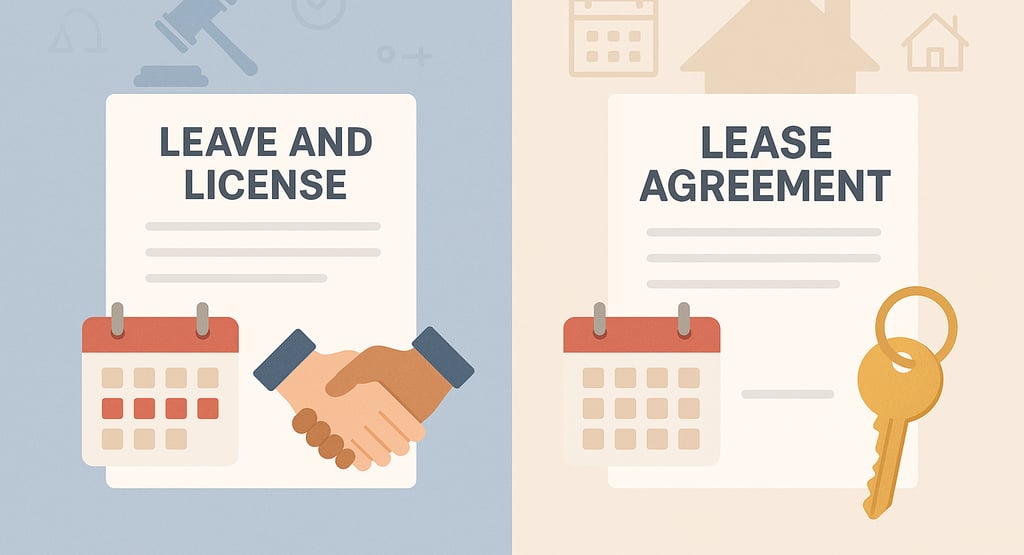Leave and License vs. Lease: Which Rental Agreement Is Right for You?
Confused between a leave and license or lease agreement? This detailed guide breaks down the legal, financial, and practical differences to help tenants and landlords make the right choice for their rental needs.
6/28/20253 min read


Renting a home sounds easy — scroll through a few listings, talk to an owner, sign a deal, move in. But in the background of every rented flat lies a key decision that most tenants overlook: Should you sign a lease or go for a leave and license agreement? Both are legal rental agreements, yet they differ significantly in terms of ownership rights, duration, legal protection, and ease of eviction.
Understanding the difference can save you from future headaches — and even from landing in a legal mess. Whether you're a tenant moving into a flat in Bangalore or a landlord listing your property in Gurgaon, here's everything you need to know.
What Is a Leave and License Agreement?
A Leave and License agreement is a legal document that gives the tenant (licensee) the right to occupy the premises temporarily. However, it does not transfer any interest or ownership rights in the property to the tenant.
Key Features:
Typically short-term (11 months is common)
Easier to revoke or renew
Ideal for landlords who want flexibility
Doesn't create tenancy rights for the occupant
Often registered under the Indian Easements Act, 1882
What Is a Lease Agreement?
A Lease is a contractual agreement that transfers an interest in the property to the tenant (lessee) for a fixed period. It gives the tenant exclusive possession and more legal protection under the law.
Key Features:
Usually for 1 year or more
Transfers possession and partial ownership rights (limited)
Falls under the Transfer of Property Act, 1882
Harder to terminate unilaterally
Offers stronger legal backing to the tenant
Legal Comparison: Lease vs. Leave and License
Here’s a quick legal breakdown of how both agreements differ on major parameters:
Feature Leave and License Lease Agreement Legal Protection Weaker for tenant Stronger tenant rights Governing Law Indian Easements Act, 1882 Transfer of Property Act, 1882 Possession Rights No legal possession Legal possession granted Duration Short-term (usually 11 months) Long-term (usually 1 year or more) Renewal Process Simple; usually auto-renewed Formal process; requires new lease Termination Easier, usually with 1 month notice Complicated; often court intervention Registration Requirement Required above 11 months Mandatory if term exceeds 11 months
Which Agreement Is More Common in India?
In cities like Bangalore, Pune, Gurgaon, and Mumbai, landlords usually prefer Leave and License agreements. Why? Because they offer more control, and evicting a tenant is far easier without going through long legal procedures.
Tenants, on the other hand, may lean toward Lease agreements if they’re looking for long-term stability — especially families who don't want frequent renewals or rent hikes.
Pros and Cons: Leave and License
Pros
Easy to execute and terminate
Flexibility in rent increase
Lesser stamp duty and registration cost (if under 11 months)
No transfer of legal possession
Cons
Limited legal protection for tenants
Often misused for illegal eviction
Not ideal for long-term stays
Pros and Cons: Lease Agreement
Pros
Strong tenant rights
Ideal for long-term residence
Stable rent and possession terms
Better clarity in legal disputes
Cons
Eviction is a lengthy legal process
Heavier stamp duty and registration fees
Less flexibility for landlords
Ideal Scenarios: When to Choose What?
Scenario Recommended Agreement You’re a student or working professional renting for <1 year Leave and License You’re a landlord who wants control and flexibility Leave and License You’re a tenant with a family, planning a long-term stay Lease Agreement You’re renting a commercial property Lease Agreement
Common Myths Busted
Myth 1: “Leave and License means I have no rights.”
Truth: While it doesn’t give you ownership or tenancy rights, a registered leave and license agreement can still protect you legally against unfair eviction if proper notice isn’t served.
Myth 2: “Lease is better in all cases.”
Truth: Lease may offer stronger rights, but it’s not always better — especially for landlords who prefer flexibility or want to avoid tenant lock-ins.
Expert Tip: Why Landlords Prefer Leave and License
Leave and License is often used in cities like Mumbai, Delhi NCR, and Hyderabad where landlords want fast, short-term turnover. It avoids the “tenancy rights” trap — where a tenant refuses to vacate and the owner is forced into legal proceedings for eviction. In fact, CirclePe’s zero-deposit model often works hand-in-hand with Leave and License agreements for this very reason: they’re easier to execute and safer for both parties.
Stamp Duty and Registration: What You Must Know
Stamp Duty differs based on your state and agreement type:
Leave and License (11 months): Low stamp duty, often 0.25%–0.5% of total rent + deposit
Lease (12+ months): Higher stamp duty, approx. 1%–2% depending on the state
Registration is mandatory for both if over 11 months.
Avoid under-the-table agreements. Always register your agreement — it legally protects both the tenant and the landlord in case of disputes.
Final Verdict: Which One Is Right for You?
It boils down to what you want from your rental:
Go for Leave and License if you want short-term flexibility, lower costs, and faster processing.
Choose a Lease if you want long-term protection, tenant rights, and stability.
Both agreements are legal, valid, and commonly used — but understanding their implications, pros, and legal backing is key to making the right choice.
Looking for Zero Deposit Rentals?
Whether it’s a leave and license agreement in Gurgaon or a lease in Pune, CirclePe helps you rent flats without the burden of security deposits. Move in with ease, pay only monthly rent, and leave the paperwork to us.
Housing India
Your source for housing insights in India.
© 2025. All rights reserved.
